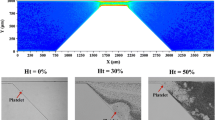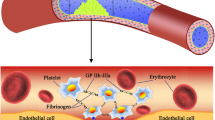Abstract
A sudden tubular expansion with a semi-permeable wall was constructed from a tubular dialysis membrane to investigate the effects of filtration flow and flow disturbance on particle deposition. The expansion was perfused with a dilute, neutrally buoyant suspension of 1.10 ώm diameter polystyrene latex spheres (as models of platelets) in Tris buffer solution containing 10% Dextran T70 and 2% bovine serum albumin. The results showed that adhesion of particles correlated positively with the filtration rate and inversely with the wall shear rate. In the vortex flow region distal to the expansion, particle adhesion was significantly elevated with a maximum at the reattachment point where the wall shear rate was the lowest and particles were constantly carried toward the vessel wall along the curved streamlines. In conclusion, filtration flow has a profound impact on the interaction of blood cells such as platelets with blood vessel walls, and the disturbed flow with a low wall shear rate can enhance the deposits of platelet thrombi to the vessel wall.
Similar content being viewed by others
References
David, T., Walker, P. G., Activation and extinction models for platelet adhesion, Biorheology, 2002, 39(3-4): 298.
Gerssiner, H. D., Mustard, J. F., Rowswell, H. C., The occurence of microthrombi on the aortic endothelium of swine, Can. Med. Assoc. J., 1962, 87: 405–408.
Packham, M. A., Rowsell, H. C., J?gensen, L. et al., Localized protein accumulation in the wall of aorta, Exp. Molec. Path., 1967, 7: 214–232.
Mitchell, J. R. A., Schwartz, C. J., The relationship between myocardial lesions and coronary artery disease, Part II: A selected group of patients with massive cardiac necrosis or scarring, Brit. Heart J., 1963, 25: 1–24.
Cotton, L. T., Clark, C., Anatomical localization of venous thrombosis, Ann. Roy. Coll. Surg. Engl., 1965, 36: 214–224.
Karino, T., Goldsmith, H. L., Particle flow behavior in models of branching vessels, Part II: Effects of branching angle and diameter ratio on flow patterns, Biorheology, 1984, 22: 87–104.
Karino, T., Kwong, H., Goldsmith, H. L., Particle flow behavior in models of branching vessels, Part I: Vortices in 90o T-junctions, Biorheology, 1979, 16: 231–248.
Karino, T., Goldsmith, H. L., Flow behaviour of blood cells and rigid spheres in an annular vortex, Philos. Trans. R. Soc. Lond. B. Biol. Sci., 1977, B279: 413–445.
Karino, T., Motomiya, M., Flow through a venous valve and its implication for thrombus formation, Thromb. Res., 1984, 36: 245–257.
Karino, T., Goldsmith, H. L., Adhesion of human platelets to collagen on the walls distal to a tubular expansion, Microvasc. Res., 1979, 17: 238–262.
Varon, D., Dardik, R., Shenkman, B. et al., A new method for quantitative analysis of whole blood platelet interaction with extracellular matrix under flow conditions, Thromb. Res., 1997, 85: 283–294.
David, T., Thomas, S., Walker, P. G., Platelet deposition in stagnation point flow: An analytical and computational simulation, Med. Eng. Phys., 2001, 23(5): 299–312.
Tedgui, A., Lever, M. J., Filtration through damaged and undamaged rabbit thoracic aorta, American Journal of Physiology, 1984, 247: H784-H791.
Wilens, S. L., McCluskey, R. T., The comparative filtration properties of excised arteries and veins, American Journal of Medical Science, 1952, 224: 540–547.
Baldwin, A. L., Wilson, L. M., Simon, B. R., Effect of pressure on aortic hydraulic conductance, Ateriosclerosis and Thrombosis, 1992, 12: 163–171.
Bartelt, K. W., Blood Platelet Deposition onto Filtering Surfaces, Minneapolis: University of Minnesota, 1976 (Thesis).
Blackshear, P. L., Bartel, K. W., Forstrom, R. J., Fluid dynamic factors affecting particle capture and retention, The Behavior of Blood and Its Components at Interface (eds. Vroman, L., Leonard, E. F.), New York: New York Academy of Science, 1977, 270–279.
Author information
Authors and Affiliations
Corresponding author
About this article
Cite this article
Deng, X., Wang, G. & Yang, Y. Experimental simulation of model platelet adhesion to a semi-permeable wall exposed to flow disturbance. Chin.Sci.Bull. 48, 2422–2427 (2003). https://doi.org/10.1360/03ww0055
Received:
Issue Date:
DOI: https://doi.org/10.1360/03ww0055




